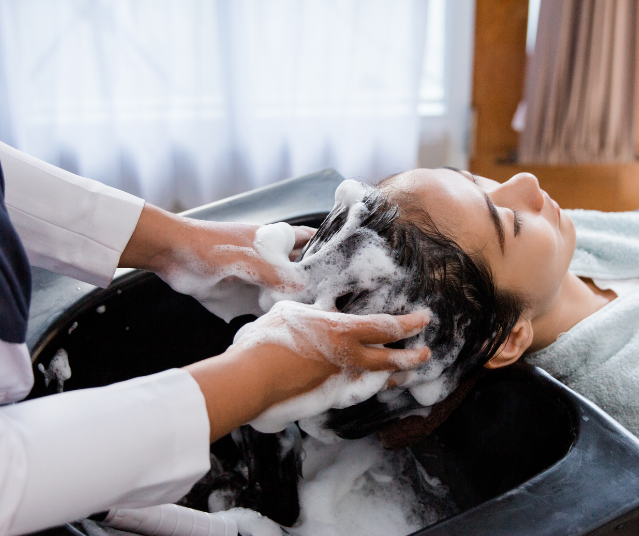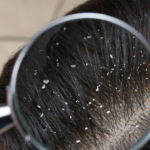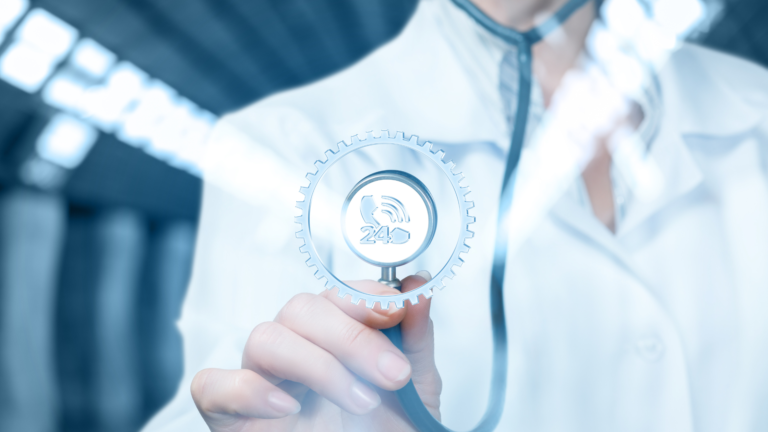Introduction
Is dandruff driving you up the wall, causing embarrassing flakes, itchiness, and even hair loss? You’re not alone. Dandruff affects millions of people worldwide, yet it remains a stubborn issue for many. We often ask ourselves: What’s the root cause, and how can we truly put an end to it?
Below, we’ll uncover 10 surprising dandruff hair solutions that go beyond the typical dandruff shampoo and delve into practical, effective ways to get rid of it for good. These strategies address not only dandruff but also dandruff-related hair fall and hair loss, offering holistic solutions for a healthy, flake-free scalp.
1. Understand What Causes Dandruff Hair Loss
Hair is often considered a reflection of overall health and well-being, and its appearance can offer important clues about how well it’s being cared for. Damaged hair is a common issue that affects many people, yet it can be challenging to pinpoint the damage, especially in its early stages. Whether you’re dealing with occasional breakage, excessive frizz, or more severe problems like thinning or split ends, recognizing the signs of damaged hair is the first step in addressing and reversing the issue.
In this article, we’ll explore how to recognize damaged hair by identifying the key characteristics that indicate your hair is in distress. By understanding these signs, you’ll be better equipped to take the necessary steps to repair and restore your hair to its healthiest state.
What Is Damaged Hair?
Before diving into the signs, it’s important to define what damaged hair actually is. Hair damage refers to any alteration in the structure or appearance of the hair that results from internal or external factors. The hair shaft, which is made of a protein called keratin, is coated by a protective outer layer called the cuticle. When the cuticle is damaged or weakened, it exposes the hair’s inner layers to further damage and environmental stress, leading to a host of problems like breakage, dryness, and loss of luster.
Damaged hair can be caused by a variety of factors, including heat styling, chemical treatments (like coloring or perming), over-washing, poor nutrition, and environmental exposure (such as UV rays or pollution). Understanding how to recognize the signs of hair damage early on can help you take action before the damage becomes irreversible.
2. Embrace the Power of Natural Oils for Dandruff Hair Treatment

Dealing with dandruff hair can be frustrating, as the persistent flakes, itching, and dryness can often disrupt your daily routine. While dandruff is common and generally harmless, it can affect both your scalp and your self-esteem, especially when it feels difficult to manage. Fortunately, nature offers a powerful and soothing remedy for dandruff: natural oils. These oils are packed with nutrients, antioxidants, and anti-inflammatory properties that can effectively address dandruff, hydrate the scalp, and promote healthier hair.
In this article, we’ll explore the benefits of using natural oils as part of your dandruff hair treatment regimen. From coconut oil to tea tree oil, we’ll cover the top oils you should embrace to keep your scalp healthy, free from flakes, and nourished.
Why Natural Oils Are Beneficial for Dandruff Hair
Before diving into the specific oils, it’s important to understand why natural oils are so effective in treating dandruff. Dandruff is typically caused by factors like dry skin, seborrheic dermatitis, Malassezia yeast overgrowth, or sensitive scalp conditions. Natural oils offer the following benefits to combat these issues:
- Hydration: Many oils have deep moisturizing properties that help combat dry scalp, which is a common cause of dandruff. By restoring moisture to the scalp, natural oils can prevent the scalp from flaking and itching.
- Anti-inflammatory Properties: Oils like tea tree oil and aloe vera have anti-inflammatory effects that can soothe an irritated scalp, reducing the redness and inflammation often associated with dandruff.
- Antifungal and Antibacterial Effects: Several oils, including tea tree oil and neem oil, have natural antifungal and antibacterial properties, helping to combat the Malassezia fungus, which is a major contributor to dandruff.
- Nutrient-Rich: Many oils, such as argan and coconut oil, are rich in vitamins and essential fatty acids, which nourish the scalp and promote healthy hair growth, helping to reduce shedding and support a healthy hair follicle.
- Balancing Oil Production: Some oils, like jojoba oil, can balance oil production on the scalp, preventing both dryness and excessive greasiness—two conditions that can contribute to dandruff.
Top Natural Oils for Dandruff Hair Treatment
Now that we understand the benefits of natural oils for dandruff hair, let’s dive into the specific oils that can help treat dandruff and promote a healthier scalp.
1. Coconut Oil: The Ultimate Moisturizer
Coconut oil is widely known for its moisturizing properties and its ability to penetrate the scalp deeply. It’s rich in lauric acid, which has antibacterial and antifungal properties that help fight off the Malassezia fungus, a leading cause of dandruff.
- How it helps: Coconut oil helps to hydrate a dry, flaky scalp, preventing moisture loss and reducing the appearance of dandruff. It also soothes irritation and reduces itching.
- How to use: Warm a small amount of coconut oil in your hands and massage it gently into your scalp. Leave it on for at least 30 minutes (or overnight) before washing it out with a mild shampoo.
2. Tea Tree Oil: The Antifungal Powerhouse
Tea tree oil is one of the most effective natural oils for treating dandruff due to its powerful antifungal and antibacterial properties. It directly targets the overgrowth of Malassezia yeast, which is often the root cause of dandruff.
- How it helps: Tea tree oil not only reduces dandruff flakes but also helps eliminate scalp infections and inflammation. Its soothing properties make it effective in calming an irritated scalp.
- How to use: Mix a few drops of tea tree oil with a carrier oil, such as coconut oil or olive oil, and massage it into your scalp. Leave it for 15–20 minutes, then wash your hair as usual.
3. Argan Oil: Nourishment for the Scalp and Hair
Argan oil is known for its hydrating and nourishing properties. It’s packed with vitamins A, C, and E, as well as essential fatty acids, which help maintain scalp health by moisturizing and balancing oil production.
- How it helps: Argan oil soothes dry, flaky scalp conditions while nourishing both the scalp and hair. It also helps restore shine and elasticity to your hair, improving its overall health and appearance.
- How to use: Massage a few drops of argan oil directly onto your scalp and hair, focusing on areas prone to dryness or dandruff. Leave it on for about 30 minutes before washing it out.
4. Jojoba Oil: Mimicking Natural Scalp Oils
Jojoba oil is often considered one of the best oils for scalp health because its chemical composition closely resembles that of the scalp’s natural oils. This helps balance the scalp’s oil production and moisturize without clogging the pores.
- How it helps: Jojoba oil moisturizes the scalp and helps prevent both dandruff and oily scalp conditions. It also has mild antifungal properties that can help treat dandruff caused by fungal overgrowth.
- How to use: Apply a few drops of jojoba oil directly to your scalp and massage gently. Leave it on for at least 20 minutes before rinsing with shampoo.
5. Olive Oil: Soothing and Hydrating
Olive oil is rich in vitamins E and K, antioxidants, and healthy fats, making it a fantastic option for dry and flaky scalps. It has both soothing and hydrating properties that can relieve irritation and promote a healthy scalp.
- How it helps: Olive oil is particularly effective for a dry scalp, providing deep hydration and reducing the buildup of dead skin cells, which can contribute to dandruff.
- How to use: Warm a small amount of olive oil and massage it into your scalp. Leave it on for 30 minutes or overnight, then wash it out thoroughly.
6. Neem Oil: The Herbal Healer
Neem oil is a traditional Ayurvedic remedy that’s been used for centuries to treat scalp conditions, including dandruff. Its antifungal, antibacterial, and anti-inflammatory properties make it ideal for soothing dandruff and preventing scalp infections.
- How it helps: Neem oil helps combat the Malassezia fungus, which contributes to dandruff, while also calming inflammation and preventing flaking. Its antimicrobial properties also keep your scalp clean and healthy.
- How to use: Mix neem oil with a carrier oil like coconut oil or olive oil and apply to your scalp. Leave it on for 30 minutes before washing your hair thoroughly.
7. Peppermint Oil: Refreshing and Stimulating
Peppermint oil is not only refreshing but also has antifungal and antimicrobial properties. It can help stimulate circulation in the scalp, encouraging healthy hair growth and reducing the symptoms of dandruff.
- How it helps: Peppermint oil cools and soothes the scalp, alleviating itching and irritation. It also has a refreshing, minty scent that can leave your hair feeling fresh and clean.
- How to use: Mix a few drops of peppermint oil with a carrier oil and massage into your scalp. Leave for about 15–20 minutes before rinsing it out.
3. Switch to a Targeted Dandruff Hair Shampoo

If you’re dealing with dandruff hair, the constant presence of flakes, itchiness, and scalp irritation can be more than just an aesthetic concern—it can affect your confidence and comfort. While dandruff is a common condition, it can also be persistent and hard to manage without the right treatment. One of the most effective ways to tackle dandruff and restore a healthy scalp is by switching to a targeted dandruff hair shampoo.
A targeted shampoo formulated specifically for dandruff is designed to address the root causes of flakiness, irritation, and excess oil production, while also promoting a clean and nourished scalp. In this article, we’ll dive into why you should consider switching to a dandruff shampoo and how it can help alleviate your dandruff problems for a healthier, flake-free scalp.
Why Switch to a Targeted Dandruff Hair Shampoo?
Dandruff is a condition that often results from a combination of factors, including dry skin, oily scalp, fungal overgrowth (particularly Malassezia yeast), and sensitivity to hair products. While you can try various home remedies or generic shampoos, switching to a targeted dandruff hair shampoo is the most reliable and efficient way to combat these underlying causes.
Here’s why you should consider making the switch:
1. Fights the Root Causes of Dandruff
Targeted dandruff shampoos are formulated with active ingredients that specifically combat the root causes of dandruff. These shampoos help balance the scalp’s natural oils, reduce fungal growth, and calm irritation, leading to a healthier scalp environment where dandruff has a harder time thriving.
- How it helps: Ingredients like zinc pyrithione, ketoconazole, and selenium sulfide are common in dandruff shampoos and have antifungal and antibacterial properties that directly target the Malassezia fungus, which is a major contributor to dandruff.
2. Relieves Itching and Inflammation
One of the most frustrating aspects of dandruff is the constant itchiness and irritation. Targeted dandruff shampoos often contain soothing ingredients like tea tree oil, aloe vera, or menthol, which can relieve itching and reduce inflammation. By addressing both the flaking and the discomfort, dandruff shampoos provide comprehensive relief.
- How it helps: Shampoos with anti-inflammatory ingredients help calm an irritated scalp, reducing redness and itching, and prevent the urge to scratch, which can worsen dandruff and even lead to hair thinning.
3. Deep Cleansing Without Stripping Natural Oils
A key challenge when managing dandruff is finding the right balance of cleansing without stripping the scalp of its natural oils. Many generic shampoos can be too harsh, leading to dryness and exacerbating dandruff. However, dandruff hair shampoos are specifically formulated to cleanse the scalp effectively while retaining its moisture balance, leaving it hydrated but not greasy.
- How it helps: Moisturizing agents like glycerin and panthenol are often included in dandruff shampoos to hydrate the scalp and keep it from becoming too dry, which can trigger more flaking.
4. Prevents Excess Oil Build-Up
For individuals with oily scalp conditions, excessive oil production can contribute to dandruff and worsen flaking. A dandruff shampoo formulated for oily scalps helps remove excess oil, preventing it from mixing with dead skin cells and forming the flakes commonly seen in dandruff hair.
- How it helps: Active ingredients like salicylic acid and sulfur target oily scalp conditions by gently exfoliating the scalp and removing dead skin cells, while also regulating oil production.
5. Promotes Healthy Hair Growth
The ongoing inflammation and irritation caused by dandruff can hinder healthy hair growth by weakening hair follicles. By reducing dandruff and soothing the scalp, a targeted dandruff shampoo can improve dandruff hair health and promote hair growth. Additionally, clearing away flakes helps keep hair follicles open and free from blockages, creating an ideal environment for healthy hair growth.
- How it helps: Ingredients like biotin and caffeine in some dandruff shampoos can help stimulate circulation to the scalp, which may promote stronger and healthier hair growth.
4. Exfoliate Your Scalp with DIY Remedies
Exfoliation isn’t just for your face—it can do wonders for your scalp as well! Gently exfoliating helps remove flakes and buildup, making it a valuable step in a dandruff hair treatment routine. You can create a DIY scrub using sugar and coconut oil or oatmeal and yogurt to exfoliate the scalp gently and effectively.
How to Exfoliate:
- Massage your scalp with your DIY scrub for 3-5 minutes before rinsing.
- Repeat once a week to prevent flakiness, irritation, and any associated dandruff hair loss.
Bonus: Exfoliating can promote blood flow, stimulating healthier hair growth and potentially reducing dandruff hair fall.
5. Tweak Your Diet to Support Scalp Health
What you eat can significantly impact your skin, including your scalp. A diet rich in zinc, B vitamins, and omega-3 fatty acids can help reduce dandruff hair and prevent related issues. Zinc is essential for skin health, while B vitamins support the production of scalp oils, reducing dryness. Omega-3 fatty acids help control inflammation, which can improve dandruff hair and minimize hair fall caused by dandruff.
Key Foods for Scalp Health:
- Zinc-rich foods: Nuts, seeds, and legumes.
- Omega-3s: Salmon, chia seeds, and walnuts.
- B Vitamins: Whole grains, leafy greens, and eggs.
Expert Insight: According to dermatologists, nutrition directly impacts scalp health, so adopting a scalp-friendly diet is one of the easiest ways to tackle dandruff and improve hair health.
6. Try Apple Cider Vinegar as a Natural Dandruff Hair Solution
Apple cider vinegar (ACV) is a natural remedy celebrated for its antimicrobial properties, making it highly effective against dandruff hair. ACV helps balance the scalp’s pH, creating an environment that discourages dandruff-causing fungi. Its mild exfoliating properties also assist in removing flakes and buildup, reducing the risk of dandruff hair fall.
Application:
- Mix one part ACV with one part water, apply it to your scalp, and leave it for 5-10 minutes before rinsing.
- Use this method twice a week for the best results.
Caution: ACV is potent, so always dilute it to prevent irritation.
7. Adopt a Scalp Massage Routine to Minimize Dandruff Hair Loss
Massaging your scalp stimulates blood flow, which can enhance dandruff hair treatment by ensuring your scalp gets the nutrients it needs. Better circulation helps relieve itching, reduce dandruff hair fall, and promote overall scalp health.
How to Massage:
- Use the pads of your fingers, not your nails.
- Focus on massaging for at least 5 minutes each time, moving in circular motions.
Added Benefit: Scalp massages not only support hair growth but also create a calming, de-stressing effect—perfect for anyone struggling with stress-induced dandruff.
8. Explore Medicated Dandruff Treatments for Persistent Issues
Sometimes, a regular anti-dandruff shampoo or home remedy isn’t enough to control dandruff hair. Persistent dandruff may require medicated solutions, often containing higher concentrations of antifungal ingredients like ketoconazole or salicylic acid. These treatments work by targeting the root cause of dandruff, effectively addressing fungal growth and inflammation on the scalp.
- Tip: Consult a dermatologist before starting any medicated treatment to ensure it’s suitable for your scalp type and hair needs.
9. Avoid Frequent Hair Styling and Heating Tools
Styling tools can contribute to dandruff hair by stripping your scalp of its natural oils, leading to dryness. Hair dyes, straighteners, and curling irons can all worsen dandruff and even increase hair loss by making your scalp more sensitive and prone to irritation.
Quick Advice: Limit your use of heat styling tools, and always apply a heat protectant if you do use them. Embracing natural styles more frequently can reduce the chance of dandruff flare-ups.
10. Hydrate and Destress: Key to Stopping Dandruff for Good
Last but not least, staying hydrated and managing stress are key factors in dandruff prevention. Stress can trigger hormonal imbalances that may lead to dandruff hair issues and even contribute to dandruff-related hair fall. On the other hand, proper hydration is essential for overall skin health, helping to keep your scalp moisturized and healthy, reducing the likelihood of dandruff.
Tips for Hydration and Stress Relief:
- Drink at least 8 glasses of water a day to maintain scalp moisture.
- Incorporate relaxation practices like yoga or meditation to reduce stress-induced dandruff.
Conclusion
So, can you stop dandruff for good? While it might seem elusive, following these steps will undoubtedly make a difference in reducing flakes, itchiness, and even dandruff hair loss. By understanding your scalp’s unique needs, exploring natural and medicated treatments, and incorporating holistic practices like proper diet and stress relief, you can achieve a healthier, dandruff-free scalp.











